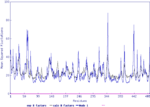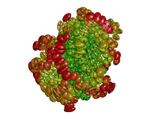Difference between revisions of "Normal Mode Analysis of Glucocerebrosidase"
(→WEBnm@) |
(→ElNémo) |
||
| Line 60: | Line 60: | ||
''' Discussion ''' |
''' Discussion ''' |
||
| + | |||
| + | The normal modes obtained with ElNémo seem to describe the same movements as the resulting normal modes of Webnm@. Most of the movement seems to be between the different domains. As observed in the results of Webnm@ the movements consists of stretching, bending, attraction, repulsion and twisting. |
||
=== Anisotropic Network Model === |
=== Anisotropic Network Model === |
||
Revision as of 04:32, 17 August 2011
Contents
Introduction
Elastic and Gaussian Network Models
WEBnm@
WEBnm@ is a web-server which provides automated computation and analysis of low-frequency normal modes of proteins. For an input structure file in PDB format, the normal modes are calculated and a series of automated calculations (normalized squared atomic displacements, vector field representation and an animation of the first six vibrational modes). Additional to the single analysis (calculating lowest frequency normal modes for one protein), the server offers a comperative analysis. In this analysis, the normal modes of a set of aligned sequences are calculated and compared. This feature is still under development. <ref>Hollup SM, Sælensminde G, Reuter N. WEBnm@: a web application for normal mode analysis of proteins BMC Bioinformatics. 2005 Mar 11;6(1):52 </ref>
Usage
- Webserver: http://apps.cbu.uib.no/webnma/home
- Input:
- Single Analysis: structure file in PDB format
- Comparative Analysis: structure files in PDB format and sequence files in fasta format
Results
Figure 1 to 5 show the first five vibrational modes (modes 7 to 11) calculated with WEBnm@ for the structure of glucocerebrosidase (2NTO). On the left side of each figure the vectors are shown, whereas the movement is illustrated to the right.
The atomic displacement of the different models is shown in the following pdf file: File:Webnma atomic displacement glucocerebrosidase.pdf. The plots show the normalized square of the displacement of each Calpha atom, whereof the highest values correspond to the most displaced regions.
Discussion
Having a look at the atomic displacements, one can see that modes 7, 9, 10 and 11 have peaks and high values all over the protein. This indicates, that most parts of glucocerebrosidase are flexible. Mode 8 describes instead local flexibilities at the N- and C- terminus of the protein. The movement consists movements and displacements of the different domains. These movements consist of streching, bending, twisting, attraction or repulsion of the different glucocerebrosidase domains.
ElNémo
ElNémo is a web-server based on the Elastic Network Model. The tool computes, visualizes and analyses low-frequency normal modes of large macro-molecules. Any size of proteins can be treated as ElNémo uses a 'rotation-translation-block' approximation. <ref>K. Suhre & Y.H. Sanejouand, ElNemo: a normal mode web-server for protein movement analysis and the generation of templates for molecular replacement. Nucleic Acids Research, 32, W610-W614, 2004. </ref>
Usage
- Webserver: http://www.igs.cnrs-mrs.fr/elnemo/start.html
- Input:
- structure file in PDB format
- supplementary options for NMA calculation (number of normal modes to be calculated, minimum and maximum perturbation and stepsize between DQMIN and DQMAX)
- options for computing the eigenmodes (NRBL and cutoff to identify elastic interactions)
Results
Figure 6 to 9 show for each of the five first vibrational normal modes calculated with ElNémo three different perspectives.
Discussion
The normal modes obtained with ElNémo seem to describe the same movements as the resulting normal modes of Webnm@. Most of the movement seems to be between the different domains. As observed in the results of Webnm@ the movements consists of stretching, bending, attraction, repulsion and twisting.
Anisotropic Network Model
The ANM Webserver provides NMA Analysis with the anisotropic network model (ANM) which is an elastic network (EN) introduced in 2000. It is a very fast method which predicts the global modes. The ANM adopts a uniform force constant γ to all springs and nodes are refered as the Cα atoms.<ref>Anisotropic network model: systematic evaluation and a new web interface, Eyal E, Yang LW, Bahar I. Bioinformatics. 22, 2619-2627, (2006)</ref>
Usage
- Webserver: http://ignmtest.ccbb.pitt.edu/cgi-bin/anm/anm1.cgi
- Input:
- structure file in PDB format or PDB id and chain
- model
- cutoff for interaction between Cα atoms in Å
- distance weight for interaction between Cα atoms
Results
After submitting the job you get a results page where you can analyze the different normal modes more precisely. You can change the amplitude and the frequency of the motions, you can visualize the vectors and change the appearance of the protein. Furthermore you have several possibilities to choose:
- download files
- create PDB (motion)
- create PyMol script
- get anisotrpic temp. factors
- B-factors/mode fluctuations
- Eigenvalues
- Correlations
- Distance fluctuations and deformation energy
- GNM
In the following we show the movement of the different modes, the distance fluctuations by the distance matrices and the deformation energy per position for each mode and the B-factors/mode fluctuations for each mode. At the end you can see the Cα anisotropic temperature factors as ellipsoids calculated in different ways.
| Mode 1 | Mode 2 | Mode 3 | Mode 4 | Mode 5 | |||||
|---|---|---|---|---|---|---|---|---|---|
| Inter Distance Analysis | |||||||||
Overall energy: 27824.672768448 |
Overall energy: 42344.496142536 |
Overall energy: 43818.992771088 |
Overall energy: 85235.1119198879 |
Overall energy: 90925.846279128 | |||||
| B-factors/mode fluctuations | |||||||||
| Mode 6 | Mode 7 | Mode 8 | Mode 9 | Mode 10 | |||||
|---|---|---|---|---|---|---|---|---|---|
| Inter Distance Analysis | |||||||||
Overall energy: 107191.169783064 |
Overall energy: 112430.078797944 |
Overall energy: 138939.176046648 |
Overall energy: 156195.358655472 |
Overall energy: 154660.33882932 | |||||
| B-factors/mode fluctuations | |||||||||
| Cα anisotropic temperature factors as ellipsoids | |||
| purely computational | refined by experimental b-factors | ||
| Rastep | Povscript | Rastep | Povscript |
Discussion
oGNM
Usage
- Webserver: http://ignm.ccbb.pitt.edu/Online_GNM.htm
- Input:
- structure file in PDB format or PDB id
- number of nodes to represent a nucleotide
- cutoff distances for amino acids and nucleotide pairs
- preferred visualization engine
Results
also available here: http://ignm.ccbb.pitt.edu/ognm/795639148/temp/index.htm
| Mode 1 | Mode 2 | Mode 3 | Mode 4 | Mode 5 |
|---|---|---|---|---|
| Mobility-Color-Coded Ribbon Diagram for modes 1 to 5. Red means high mobility, blue low mobility. | ||||
| Fluctuations per residue for modes 1 to 5 | ||||
| Cross-correlation plot for mode 1 to 5 | ||||
NOMAD-Ref
NOMAD-Ref is a webserver for normal mode analysis. By simplifying the potential energy between atoms all atoms can be used. This is possible by using the Tirion calculation of normal modes.<ref>Tirion, Monique M. Large Amplitude Elastic Motions in Proteins from a Single-Parameter, Atomic Analysis. Phys Rev Lett, 77, 1905--1908 (1996).</ref> NOMAD-Ref provides pdb-files for pymol and the elastic network of different normal modes, a graph with the RMSD values per residue and a modes.dat file with gives information about the frequency of the modes and the eigenvectors.
Usage
- Webserver: http://lorentz.dynstr.pasteur.fr/nma/submission.php
- Input:
- PDB file
- number of modes to calculate
- distance weight parameter in Å
- cutoff to use for mode calculation in Å
- average RMSD (Angstrom) in output trajectories
Results
Modes 1-6 are rigid body motions, so the interesting ones are mode 7-11. For each mode we have three figures:
- a) shows the motion of the protein - for modes 1-6 there are no real motions because these are rigid
- b) shows the elastic net together with the protein
- c) shows the rmsd per residue
| Mode 1 | Mode 2 | Mode 3 | Mode 4 |
|---|---|---|---|
| Mode 5 | Mode 6 | Mode 7 | Mode 8 |
|---|---|---|---|
| Mode 9 | Mode 10 | Mode 11 |
|---|---|---|
|
|
Discussion
Discussion
Comparison of All-atom NMA to Elastic Network NMA
In this section, all-atom normal mode analyses are compared to the normal modes based on elastic networks. Instead of glucocerebrosidase (our main protein of interest) 1BPT was chosen, as it is quite small and therefore enables a quite fast all-atom normal mode analysis.
All-Atom NMA
1BPT at 600 K
1BPT at 2000 K
Elastic Network NMA
The following images show the normal modes 7 to 10 for 1BPT created with Nomad-Ref.
Comparison NMA / MD
References
<references/>

































































































